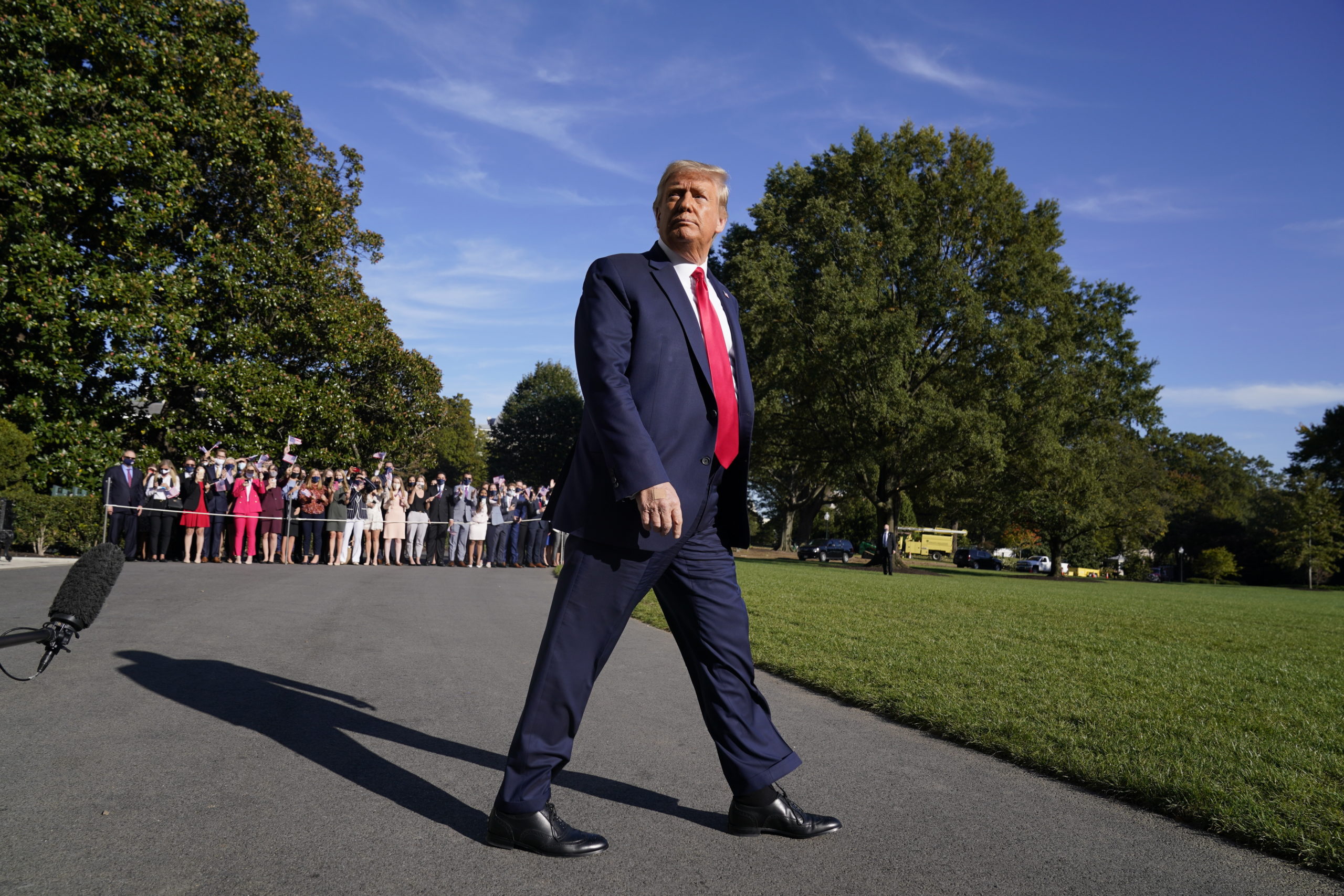In the weeks following the 2016 election, Sinclair Lewis had been dead for as long as he’d lived — 65 years — but there he was on the bestseller list in Amazon’s Classic Literature section. His 1935 vision of a fascist takeover in America, “It Can’t Happen Here,” seemed suddenly relevant again in light of recent events, along with Hannah Arendt’s works and other cautionary tales of fascism’s rise in Europe.
As the 2020 election approaches, the authoritarian tendencies that were merely rhetoric in Donald Trump’s campaign are now starkly manifest in his administration’s policy, politics, and near-daily assaults on the norms and institutions that keep democracy functioning.
And yet, what should be an urgent, constant, Klaxon-decibel alarm about the risk to our democracy is instead little more than a faint background buzz in most news coverage of the president.
Related Reading
With mis- and disinformation campaigns heating up, a vacancy on the supreme Court, and a President who refuses to commit to accepting the results, the 2020 election arrives at a period of extraordinary uncertainty and tension. Nieman Reports and Nieman Lab are publishing a collection of stories exploring how newsrooms are covering this intensely contested vote and its aftermath.
“We Can’t Only Be Mad at Facebook: Nonprofits, Newsrooms Team Up Against Misinformation“
By Catherine Buni, Nieman Reports
The election could be contested and last for weeks after Nov. 3. Here’s what experts think journalists should know.
By Sarah Scire, Nieman Lab
Critical Coverage: Cable News and Trump’s Covid-19 Diagnosis
By Celeste Katz Marston
It’s worth asking if we — especially those of us in journalism — learned anything from revisiting Lewis, Arendt, and others who carefully studied how democracies can give way to authoritarianism, or if we have learned from the debacle of the coverage of the 2016 election and why some of journalism’s practices and standards have failed us.
If there is any doubt about Trump’s growing authoritarianism, we have objective and rigorous means to assess his behavior by comparing it to that of rulers in other countries where democracy has failed. In their 2018 book “How Democracies Die” Harvard University political scientists Steven Levitsky and Daniel Ziblatt examine the experience of other countries, such as Hungary and Turkey, where democracy gave way to authoritarianism. They created a checklist of the key characteristics of authoritarian behavior to watch for, and — spoiler alert — Trump checks every box. Repeatedly.
Consider just a few of the items on the checklist:
- Have they praised acts of political violence? Have they tacitly endorsed violence by their supporters?
- Do they attempt to undermine the legitimacy of elections, for example, by refusing to accept credible electoral results?
- Do they baselessly describe their partisan rivals as criminals?
- Have they threatened to take legal action or other punitive action against critics or the media?
The past few weeks alone provide enough examples to fill out an authoritarian checklist bingo card.
Trump has defied standard views of political left and right with his unorthodox populism and the blend of protectionist tariffs, market interventions, and bailouts, alongside standard conservative fare such as tax cuts and religious moral appeals. The Levitsky/Ziblatt checklist allows us to see that the consistent throughline of Trumpism is authoritarianism.
But the dominant news coverage rarely, if ever, points out that Trump is regularly engaging in dangerous hallmarks of authoritarianism. Instead we get a bland normalizing of behavior, descriptions of Trump’s “showmanship,” or explanations that he was joking about, say, ignoring term limits.
Most journalists have a default setting for fairness, balance, and nonpartisan coverage of political campaigns, and are steeped in the norms and standards that guide good journalism.
But we must understand the origin and basis for those norms and standards. Accepted practices of fair political coverage were developed within a set of assumptions about the elected leaders and candidates journalists would be covering.
Yes, competing candidates would bring forward conflicting ideas and ideologies, but it was understood that these differences would reside within boundaries — norms of behavior about democracy and its institutions. The press might be confrontational, but they are not “enemies of the people.” You disagree with your opponent, but you don’t promise to “lock her up.” You promise to win, but you will also pledge to accept the outcome of the election. Such norms are what Levitsky and Ziblatt called the “soft guardrails of American democracy.”
Trump has long since crashed through those guardrails and sent us careering toward cliffs, yet we still cling to the safe, comfortable, “respectable” practices of political coverage. Years of complaints about bias have left many outlets shy of any coverage that would call out dangerous rhetoric and behavior.
Rather than following old practices out of habit or fear, we must examine the rationale for those practices and decide for ourselves if they still serve us, the public, and our role in a democratic society. Clearly, they do not meet the urgent task at hand. In fact, the standards of fairness and balance that have guided political journalism for decades have been hijacked and used to cloak Trump’s authoritarianism and democracy’s rapid decay.
Once journalists acknowledge that our standard practices were premised on an assumption of democratic behavior, we can begin to think about better ways to report on authoritarian behavior. We have no obligation to apply our routine practices for coverage to a candidate — even the president — who is clearly not operating to uphold democracy. This is not a matter of favoring a Democrat or a Republican, it’s about keeping our democratic republic alive.
A number of journalists and academics have been making this point, or something like it, since 2016. Washington Post media critic Margaret Sullivan, especially, has effectively and consistently pointed out that the press was bamboozled by the sheer volume of outrages this White House expels. “Every day — sometimes every hour — there’s some new craziness to distract us … Journalists are whipsawed. The public tunes out in disgust.” She correctly identified how “we willingly — almost helplessly — magnified his message.” Building on this diagnosis, professor and media critic Jay Rosen, especially, has argued for a possible remedy, an “emergency setting” for White House coverage.
But an occasional hand-wringing opinion piece in the Post or Times, or think piece in The Atlantic or The New Yorker is not sufficient to meet the scale of the threat and will not reach the audiences that matter most. Also, these critics have not made plain enough the underlying imperative driving the need for a different approach to covering this president. You’ll hear a lot of focus on Trump’s lies and misleading statements, and whether to call them lies. You’ll read a lot about his racist statements, and whether they should be called racist. But there is still insufficient focus on the most dangerous aspect of this president.
Here, it is useful to organize our thinking about Trump and prioritize which of his actions truly warrant a different approach in coverage. I’ve come to a system I call the three C’s. Those are Character, Competence, and Constitutionality.
On character, well… more than 20,000 false statements, allegations of sexual assault, failure to pay taxes, racist statements and actions, the name calling, and need we go on?
Competence? See coronavirus.
As troubling as these are, it is the third C, Constitutionality, that looms largest. Trump’s authoritarianism presents a true national emergency because the demolition of democratic norms and institutions now underway threatens to remove the very means by which we might address other pressing issues.
Eight scientists, writing the day after Scientific American's groundbreaking presidential candidate endorsement — the first in the magazine’s 175-year history — was published, clearly recognized this threat: “What is now under attack is the very possibility of addressing these deep systemic problems through a participatory, cooperative, deliberative, democratic process.”
Why are these scientists — who are normally inclined to shun political controversy — able to recognize this, and willing to call it out, while so many in journalism are not? It is because the institutional practices of science enable this. “Scientists are trained to separate truth from fiction, signal from noise,” they wrote. “We can spot scientific disinformation, which is a hallmark of authoritarianism.”
Alas, the institutional practices of journalism, when practiced reflexively and without reflection on their true nature, are keeping us from taking clear and necessary action.
The main body of daily journalism must explicitly and urgently explain to readers, listeners, and viewers the reality and implications of what we are witnessing. This must include local news outlets covering Trump rallies and interviewing supporters, for example. It must include questioning our elected officials about their view of Trump’s authoritarian behavior. We must also do more to better cover the social and economic conditions, such as inequality and institutional racism, that provide fertile ground for demagoguery.
Now we are in the final stretch of an election that could very well become an authoritarian attempt to defy election results by an incumbent who would refuse to concede and instead challenge the legitimacy of the election. Trump is already daily laying the groundwork for this.
In a 30-day period from mid-August to mid-September, Trump tweeted more than two dozen times about a “fraud” or “hoax” in reference to mail-in ballots and the election. That’s more than he tweeted about jobs, the economy, or coronavirus in the same period.
Undermining the election is a central theme of his campaign. Trump told a rally audience that he is “counting on the federal court system” to declare a winner quickly, even though election officials warn that counting absentee ballots could take more time. And of course this comes as he pushes to fill a Supreme Court vacancy less than a month before an election. Trump has repeatedly refused to commit to a peaceful transfer of power after the election.
By any reasonable reckoning this should be considered a national emergency. And yet, is that the tone of the coverage? Do you get a sense of emergency from the Politico playbooks, NPR’s careful coverage of the Cleveland “debate,” the Sunday talk shows? Mostly what I hear is some variation of, no, it can’t happen here.
Like many others I reread “It Can’t Happen Here” in 2016 and I was reminded that Lewis’ main character is a journalist. Doremus Jessup is editor of a small but respectable Vermont newspaper, the Daily Informer. As the populist demagogue Buzz Windrip comes to power, Jessup at first sticks to the accepted decorum for journalists, offering fairness and balance.
When he begins to recognize the first outlines of the rising threat, he supposes he could “write another editorial viewing-with-alarm, I suppose!”
Only later — too late — when the country is in the firm grip of authoritarian rule, does Jessup realize his error.
“It’s the fault … of all the conscientious, respectable, lazy-minded Doremus Jessups,” he chastises himself, “who have let the demagogues wriggle in, without fierce enough protest.”
Friends, the time for fierceness is now.



